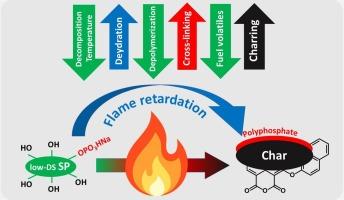低取代淀粉磷酸盐的热解和潜在阻燃性研究
IF 10.7
1区 化学
Q1 CHEMISTRY, APPLIED
引用次数: 0
摘要
研究人员利用正磷酸钠对不同的淀粉进行了无溶剂和半干法磷化处理,对其热分解和潜在的阻燃性能进行了研究。对取代度为 DSP < 0.5 的低取代度淀粉磷酸盐 (SP) 样品进行了差示扫描量热法、热重法和挥发气体分析法以及热解-气相色谱-质谱法分析。获得的数据以及使用显微镜和光谱方法检测的炭化残留物的特征与通过各种光谱技术分析的 SP 的结构方面有关,并与原生淀粉的结构方面进行了比较。研究发现,如果 DSP 至少为 0.1,固体 SP 残留物的炭化、多磷酸盐形成和热阻会显著增加。因此,与本地淀粉相比,SP 的放热分解、温度引起的质量损失和分解率明显下降。即使在 DSP < 0.1 时,SP 的活化温度和低分子热解产物(包括脂肪族、环状和芳香族醛和酮以及无水糖)的形成也明显下降。结果证实,尽管磷酸化程度较低,但 SP 在气相和凝聚相中都具有潜在的阻燃性。本文章由计算机程序翻译,如有差异,请以英文原文为准。

Studies on the pyrolysis and potential flame retardancy of low-substituted starch phosphates
Investigations on the pyrolysis and potential flame retardancy imparted by solvent-free and semi-dry phosphorylation of different starches using sodium orthophosphates were conducted. The samples – low-substituted starch phosphates (SP) with degrees of substitution DSP < 0.5 - were subjected to differential scanning calorimetry, thermogravimetry coupled with evolved gas analysis and pyrolysis – gas chromatography – mass spectrometry. The data obtained as well as features of charring residues examined using microscopic and spectroscopic methods were related to structural aspects of SP – analysed by means of various spectroscopic techniques - and compared with those of native starches. It was found that charring and polyphosphate formation and the thermal resistance of the solid SP residues increased significantly if the DSP was at least 0.1. Accordingly, the exothermal decomposition, the temperature-induced loss of mass and the decomposition rates of SP decreased distinctly compared to native starch. The activation temperatures of SP and the formation of low-molecular pyrolysis products including aliphatic, cyclic, and aromatic aldehydes and ketones as well as anhydrosugars decreased markedly, even at DSP < 0.1. The results confirm the potential flame-retardancy of SP achieved by flame-inhibiting effects, despite low phosphorylation degrees, in both the gas and condensed phases.
求助全文
通过发布文献求助,成功后即可免费获取论文全文。
去求助
来源期刊

Carbohydrate Polymers
化学-高分子科学
CiteScore
22.40
自引率
8.00%
发文量
1286
审稿时长
47 days
期刊介绍:
Carbohydrate Polymers stands as a prominent journal in the glycoscience field, dedicated to exploring and harnessing the potential of polysaccharides with applications spanning bioenergy, bioplastics, biomaterials, biorefining, chemistry, drug delivery, food, health, nanotechnology, packaging, paper, pharmaceuticals, medicine, oil recovery, textiles, tissue engineering, wood, and various aspects of glycoscience.
The journal emphasizes the central role of well-characterized carbohydrate polymers, highlighting their significance as the primary focus rather than a peripheral topic. Each paper must prominently feature at least one named carbohydrate polymer, evident in both citation and title, with a commitment to innovative research that advances scientific knowledge.
 求助内容:
求助内容: 应助结果提醒方式:
应助结果提醒方式:


